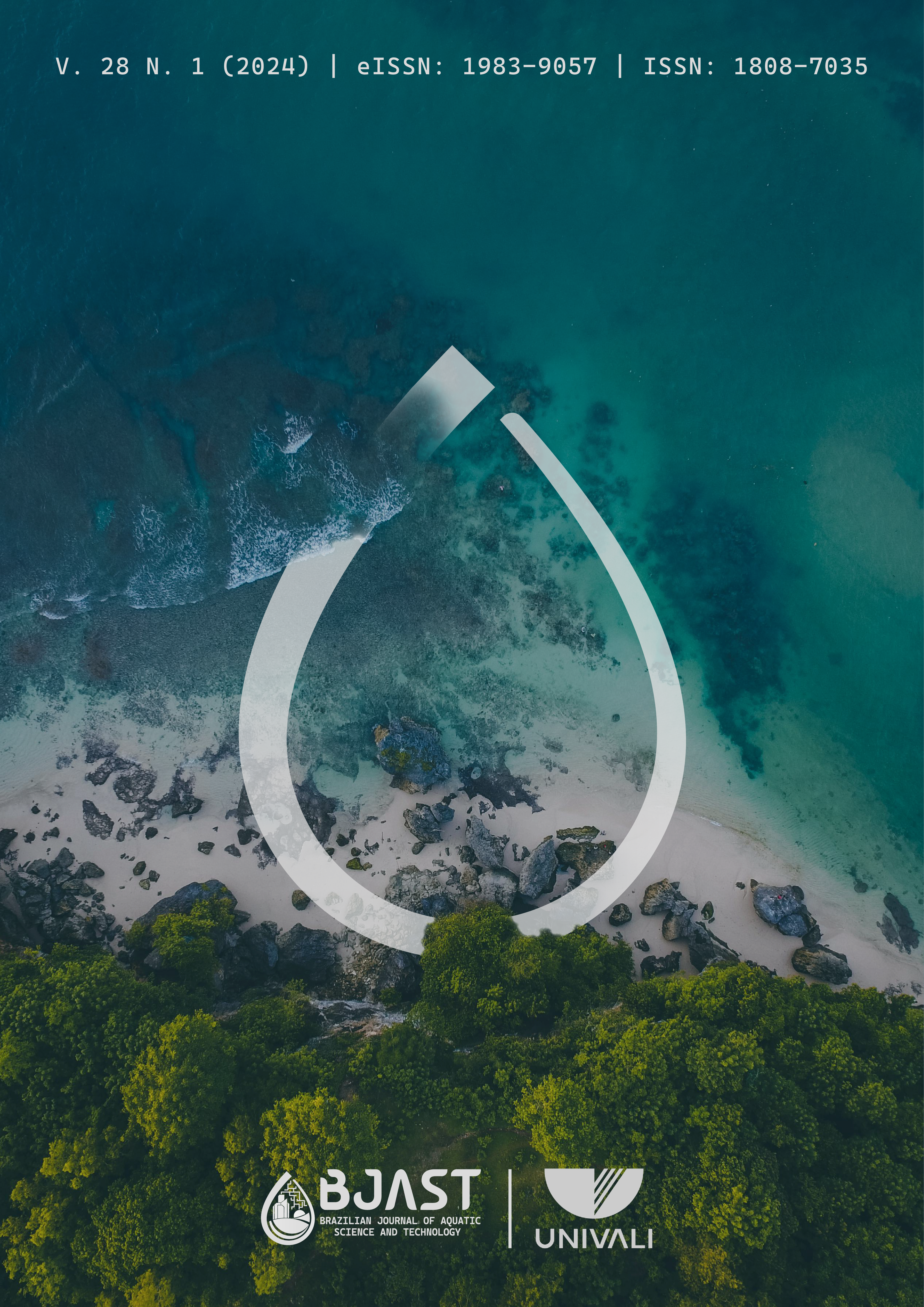

Abstract




Agência Nacional de Águas – ANA (Brazil). 2015. Portal da qualidade das águas. Indicadores de qualidade. Índice de qualidade das águas (IQA). Disponível em: http://portalpnqa.ana.gov.br/indicadores-indice-aguas.aspx.
Akinnawo, S. O. 2023. Eutrophication: Causes, consequences, physical, chemical and biological techniques for mitigation strategies. Environmental Challenges, 12, 100733.
Almanza-Marroquín, V., Figueroa, R., Parra, O., Fernández, X., Baeza, C., Yañez, J., & Urrutia, R. 2016. Bases limnológicas para a gestão de los lagos urbanos de Concepción, Chile. Latin American Journal of Aquatic Research, 44(2), 313-326.
Alves, I.C.C., El-Robrini, M., Santos, M.L.S., Monteiro, S.M., Barbosa, L.P.F., & Guimarães, J.T.F. 2012. Qualidade das águas superficiais e avaliação do estado trófico do Rio Arari (Ilha de Marajó, norte do Brasil). Acta Amazônica, 42(1), 115–124.
Arya, S., & Kumar, A. 2023. Evaluation of stormwater management approaches and challenges in urban flood control. Urban Climate, 51, 101643.
Baptista, Márcio Benedito; Cardoso, Adriana Sales. 2013. Rios e cidades: uma longa e sinuosa história. Revista da Universidade Federal de Minas Gerais, 20(2), 124-153.
Bem, C.C., Braga, M.C.B., & Azevedo, J.C.R. 2013. Avaliação de um lago urbano raso. Revista de Gestão de Água da América Latina, 10(1), 41-50.
Bucci, M. H., & Oliveira, L. F. C. D. 2014. Índices de qualidade da água e de estado trófico na represa Dr. João Penido (Juiz de Fora, MG). Revista Ambiente & Água, 9, 130-148.
Cunha, D.G.F., & Calijuri, M.C. 2011. Limiting factors for phytoplankton growth in subtropical reservoirs: the effect of light and nutrient availability in different longitudinal compartments. Lake and Reservoir Management, 27, 162–172.
Cunha, D.G.F., Calijuri, M.C., & Lamparelli, M.C. 2013. A trophic state index for tropical/subtropical reservoirs (TSI/tsr). Ecological Engineering, 60(1), 126-134.
D'Alessandro, E., & Nogueira, I. 2018. Avaliação do índice de estado trófico no Lago dos Tigres, Britânia, Goiás. Revista Gestão & Sustentabilidade Ambiental, 7(3), 98-128.
De Jonge, V. N., Elliott, M., & Orive, E. 2002. Causes, historical development, effects and future challenges of a common environmental problem: eutrophication. In Nutrients and Eutrophication in Estuaries and Coastal Waters: Proceedings of the 31st Symposium of the Estuarine and Coastal Sciences Association (ECSA), held in Bilbao, Spain, 3–7 July 2000 (pp. 1-19). Springer Netherlands.
Dixon, P., 2003. VEGAN, a package of R functions for community ecology. Journal of vegetation science, 14(6), 927-930.
Esteves, F.A. 2011. Fundamentos de Limnologia. Rio de Janeiro: Interciência, 3 ed., v. 1, 790.
Fabrin, T.M.C., Stabile, B.H.M., da Silva, M.V., Jati, S., Rodrigues, L., & de Oliveira, A.V. 2020. Cyanobacteria in an urban lake: hidden diversity revealed by metabarcoding. Aquatic Ecology, 54(2), 671-675.
Gao, Y., Deng, Z., & Morrison, A.M. 2019. Can Urban Lake Recreational Pressure Be Measured? The Impacts of Urbanization on Wuhan’s Lakes. Applied Spatial Analysis and Policy, 12(2), 255-273.
Golterman, H.L., Clymo, R.S., & Ohnstad, M.A.M. 1978. Methods for physical and chemical analysis of freshwater. IBP. Oxford, Blackwell Scientific Publication, 2 ed.
Jati, S. 2019. Revisão do Plano de Manejo do Parque do Ingá: Condições limnológicas e vegetação terrestre. Universidade Estadual de Maringá.
Kassambara, A., & Mundt, F., 2017. Package ‘factoextra’. Extract and visualize the results of multivariate data analyses, 76(2).Legendre P. & Legendre L., 1998. Numerical ecology. Developments in environmental modelling, 20.
Lê, S., Josse, J., & Husson, F., 2008. FactoMineR: an R package for multivariate analysis. Journal of statistical software, 25, 1-18.
Maack, R. 1981. Geografia física do Estado do Paraná. Rio de Janeiro: Livraria José Olympio Editora.
Mackereth, F.Y.H., Heron, J.R., & Tailing, J.F. 1978. Water analysis: Some revised methods for limnologists. Freshwater Biological Association Scientific Publication.
Nabout, J.C., & Nogueira, I.S. 2011. Variação temporal da comunidade fitoplanctônica em lagos urbanos eutróficos. Acta Scientiarum. Biological Sciences, 33(4), 383-391.
Oberholster, P. J., Botha, A. M., & Cloete, T. E. 2006. Toxic cyanobacterial blooms in a shallow, artificially mixed urban lake in Colorado, USA. Lakes & Reservoirs: Research & Management, 11(2), 111-123.
R Core Team: A language and environment for statistical computing. R Foundation for Statistical Computing, Vienna, Austria, 2023. https://www.R-project.org/.
Reynolds, C.S. 2006. Ecology of phytoplankton. Cambrigde: Cambrigde University Press.
Rosińska, J., Kozak, A., Dondajewska, R., & Gołdyn, R. 2017. Cyanobacteria blooms before and during the restoration process of a shallow urban lake. Journal of Environmental Management, 198, 340-347.
Santos, A.O. 2003. Caracterização do reservatório no Parque do Ingá, em Maringá-PR no que diz respeito a seus aspectos limnológicos. Dissertação (Mestrado em Geografia) – Universidade Estadual de Maringá, Maringá.
Silva, M.V., Bortolini, J. C., & Jati, S. 2022. The phytoplankton community as a descriptor of environmental variability: a case study in five reservoirs of the Paraná River basin. Acta Limnologica Brasiliensia, 34.
Silva, M.V., & Jati, S. 2024. Rainfall increases the biomass and drives the taxonomic and morpho-functional groups variability of phytoplankton in a subtropical urban lake. Acta Limnologica Brasiliensia, 37.
Vaz, S.R. 1998. Dinâmica do chumbo no lago do Parque do Ingá, Maringá, PR, Brasil. Brazilian Archives of Biology and Technology, 41, 457-466.
Viana, R.B., Cavalcante, R.M., Braga, F.M.G., Viana, A.B., Araújo, J.C., Nascimento, R.F., & Pimentel, A.S. 2009. Risk assessment of trihalomethanes from tap water in Fortaleza, Brazil. Environmental Monitoring and Assessment, 151, 317-325.
Zhou, J., Leavitt, P. R., Zhang, Y., & Qin, B. 2022. Anthropogenic eutrophication of shallow lakes: is it occasional?. Water Research, 221, 118728.






Environmental Sciences, Aquatic and Coastal Environments.
BJAST adopts the policy of continuous publication of articles. Therefore, whenever a manuscript is approved for publication, it will be immediately available for reading.

